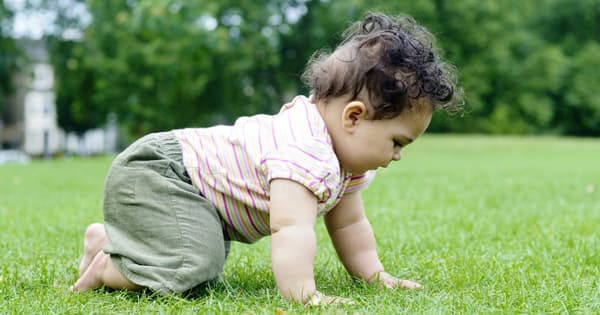Crawling provides many wonderful experiences for your child and aids in the development and strengthening of other areas. If your child hasn’t started creeping or crawling by nine months, it’s time to see your pediatrician or a physical therapist. Crawling is your baby’s first and longest period of putting weight through their hands to develop strength and stability at their shoulders.
Crawling is thought to be the earliest form of independent movement. It aids in the development and improvement of our vestibular/balance system, sensory system, cognition, problem-solving abilities, and coordination. According to a University of Otago study, the more crawling experience a baby has, the more likely they are to avoid falling into the water. The study, published in the journal Infancy, is part of a long-term investigation into the effect locomotor experience has on infants’ avoidance of falling over sudden drop-offs.
The researchers tested babies’ behavior around a tub filled with water, dubbed a water drop-off, according to lead author Dr. Carolina Burnay of the School of Physical Education, Sport, and Exercise Sciences. “The amount of crawling experience they had was the main difference between the babies who fell and those who avoided falling in the water.”
Crawling is an important milestone in your child’s development. The more crawling experience a baby has, the more likely they are to avoid falling into the water, a new study shows.
“A very interesting result was that the amount of prior crawling experience they had informed their perception of risk and behavior even when they were already walking,” she says. “Thus, it appears very helpful for babies to crawl and explore their environment.” The findings run counter to the current trend of ‘helicopter parenting.’
“Caregivers should be aware of the critical role crawling plays in infant development, as well as the benefits of encouraging crawling opportunities for their infants.” Infants learn to distinguish safe from unsafe surfaces to locomote and begin avoiding falls, whether into water or not, by touching the floor and looking closely at it.
“Overprotecting babies by limiting their opportunities to self-locomote does not keep them safe; rather, it delays their development of risk perception.” Dr. Burnay also studied how babies interact with a slope leading to the water.

The study, which was recently published in Developmental Psychobiology, allowed babies to move into the water down a gradual slope, much like a beach leading to the ocean. In this case, locomotor experience had no effect on babies’ behavior; on the slope, they were more likely to engage in risky behavior than on the drop-off.
“Before these studies, we knew statistics about baby drowning, such as how many babies drown each year, how many drowning incidents occur on beaches or in swimming pools, and what ages are most represented in drowning statistics.” This new approach is looking into how infants interact with bodies of water, when and how they start perceiving the risk of drowning, and how they avoid drowning.
“If we want to develop better drowning prevention strategies for young children, we need to understand how they interact with bodies of water and how they learn to perceive the consequences of interacting with bodies of water,” Dr. Burnay says.
The study also emphasizes the dangers that slopes into bodies of water pose to babies. Parents and those working in water safety should be extra cautious around such access points and prevent infants from using them in aquatic environments.
If your baby enjoys tummy time, keep exposing them to it through play to increase their tolerance and skill set. If your baby dislikes his or her tummy, continue working on it in short bursts and in different positions. Put a towel under their arms to provide support so they can concentrate on lifting their heads, or place them on your chest in a reclined position to eliminate gravity. This makes it easier for your baby to push through their arms and lift their head.
Dr. Burnay is continuing her research into how babies interact with bodies of water and is looking for participants (crawlers or walkers under the age of 18 months) for testing at Dunedin’s Moana Pool. The babies who were tested on the water cliff were from Portugal, while those who were tested on the water slope were from Dunedin. She is testing babies in both situations to see if the differences are due to cultural differences.
















